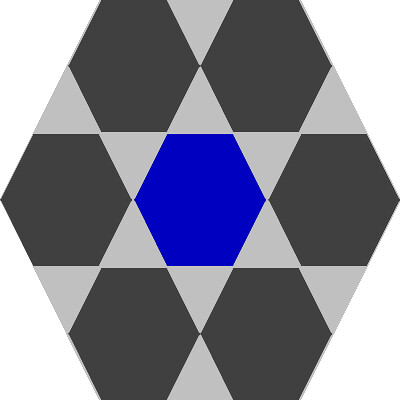This doesn't need to be a tiled hex system like the overland. It's just an added layer of strategy.
Set up like this, you could have 2 "frontline" units, as each edge has 2 subhexes in contact with an adjacent hex.
Natural flanking occurs because every subhex (except for the center) is in contact with two adjacent large hexes.
This.
Except it isn't necessary to explicitly provide a tactical grid. A similar effect could be achieved by instituting a 6UPT limit and developing a set of rules with respect to combat operations.
For the purposes of this discussion I'm defining three categories of units - melee (i.e. front line - swordsmen, pikemen, etc); cavalry; ranged fire. You can split it more finely, but for the purposes of conveying my ideas, this will work.
So here is the idea.
On defence:
1. If bombarded, check whether the defending tile has any artillery type units. If yes, then %chance of counterbattery fire. Max 1 counterfire per ranged attack. A defending unit may only counterfire once.
2. If attacked. First run the counter artillery fire check. Then assign a melee unit to that side of the hex. If no melee unit is available, then assign a cavalry unit to that side of the hex. If no cavalry unit is available, then assign a ranged unit to that side of the hex. Whatever unit ends up defending is now commited to that side of the hex. Any subsequent attacks on that side will be against that unit. The assigned unit will not be available to defend against attacks made on any other side of the hex.
On offence:
1. Bombarding units may choose whether to aim at front line or enemy artillery. Modern era bombarding units may have multitile range, but up until the modern era it would be kept to 1-tile range.
2. Attackers (cavalry and melee) are assigned to the corners of a hex - this allows up to two attacks to be made from the attacking hex against a single side (and therefore a single defender) of a defending hex. This preserves the ability to concentrate fire which is a key part of the 1UPT system.
Rationale:
Easier for the AI to handle. The AI is lousy at combat on 1UPT. It doesn't understand unit formations well at the tactical level (e.g. protect those archers!). Introducing a finer grain tactical map won't help with this. In fact, given the complexity of some of the ideas above, it may just make things worse with respect to AI pathfinding and formation forming. Shifting to a 6UPT system as above basically assumes optimal formation on each tile through the rules of engagement. The decision factor is simplified - instead of force composition AND formation, the AI only really needs to understand composition.



